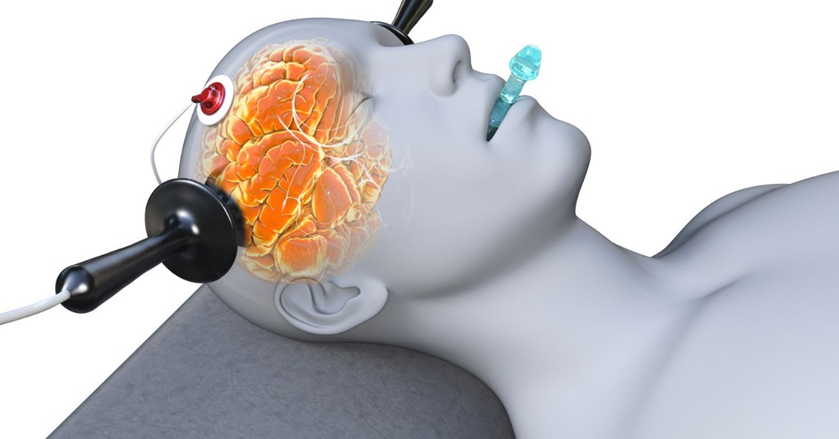A nurse is teaching a client who has major depressive disorder about electroconvulsive therapy. Which of the following information should the nurse include?
"This therapy works as a cure for major depressive disorders."
"You will be awake and alert during the procedure."
"You might experience confusion for a few hours after treatment."
"This therapy will stimulate the vagus nerve to improve your mood."
The Correct Answer is C
Choice A reason:
Electroconvulsive therapy (ECT) is not considered a cure for major depressive disorders. While ECT can be highly effective in alleviating symptoms of severe depression, it does not prevent future episodes. Patients often require ongoing treatment with medications or psychotherapy to maintain the benefits of ECT.
Choice B reason:
During ECT, the patient is not awake and alert. The procedure is performed under general anesthesia, meaning the patient is unconscious and does not feel the electrical stimulation or the induced seizure. This ensures the procedure is painless and the patient is unaware during the treatment.
Choice C reason:
It is common for patients to experience confusion for a few hours after ECT. This confusion is partly due to the anesthesia and partly due to the treatment itself. In most cases, the confusion resolves within a few hours, but it can sometimes last longer, especially in older adults.
Choice D reason:
ECT does not stimulate the vagus nerve. Vagus nerve stimulation (VNS) is a different treatment that involves using a device to send electrical impulses to the vagus nerve. ECT works by inducing a controlled seizure in the brain, which can help alleviate symptoms of severe depression.

Nursing Test Bank
Naxlex Comprehensive Predictor Exams
Related Questions
Correct Answer is C
Explanation
Choice A reason:
A client with anorexia nervosa expressing a fear of gaining weight does require careful monitoring and intervention, but this does not typically pose an immediate risk to their safety. The treatment plan should focus on addressing the eating disorder and any associated psychological issues, but it may not necessitate an urgent change in the plan of care regarding safety concerns.
Choice B reason:
While a client with schizophrenia exhibiting tangential associations in speech indicates a need for ongoing psychiatric care, it does not inherently suggest an immediate risk to safety that would require an urgent update to the care plan. These speech patterns are a symptom of schizophrenia and should be addressed through appropriate therapeutic and medication management strategies.
Choice C reason:
A client with bipolar disorder exhibiting poor impulse control presents an immediate safety concern. Poor impulse control can lead to risky behaviors, self-harm, or harm to others. This situation requires an urgent update to the care plan to include safety measures such as close supervision, environmental modifications, and possibly medication adjustments to manage impulsivity.
Choice D reason:
A client with Alzheimer's disease having difficulty remembering the names of family members is experiencing a symptom of their condition. While this is distressing and requires a compassionate approach to care, it does not typically pose an immediate safety risk that would necessitate an urgent update to the care plan.
Correct Answer is D
Explanation
Choice A reason:
While being oriented to person, place, and time is important, it does not necessarily indicate that the client is no longer a risk to themselves or others. Orientation alone does not ensure that the client can safely be without restraints.
Choice B reason:
Refusing medication unless released from restraints is a form of coercion and does not indicate that the client is safe to be without restraints. The decision to remove restraints should be based on the client's ability to follow commands and demonstrate safe behavior, not on their demands.
Choice C reason:
If a client states that they will harm themselves unless the restraints are removed, this indicates a high risk of self-harm. In such cases, restraints should not be removed until the client is assessed and deemed safe by a healthcare professional.
Choice D reason:
The ability to follow commands is a key indicator that the client can be safely managed without restraints. This demonstrates that the client is cooperative and can adhere to safety instructions, reducing the risk of harm to themselves or others.
Whether you are a student looking to ace your exams or a practicing nurse seeking to enhance your expertise , our nursing education contents will empower you with the confidence and competence to make a difference in the lives of patients and become a respected leader in the healthcare field.
Visit Naxlex, invest in your future and unlock endless possibilities with our unparalleled nursing education contents today
Report Wrong Answer on the Current Question
Do you disagree with the answer? If yes, what is your expected answer? Explain.
Kindly be descriptive with the issue you are facing.
